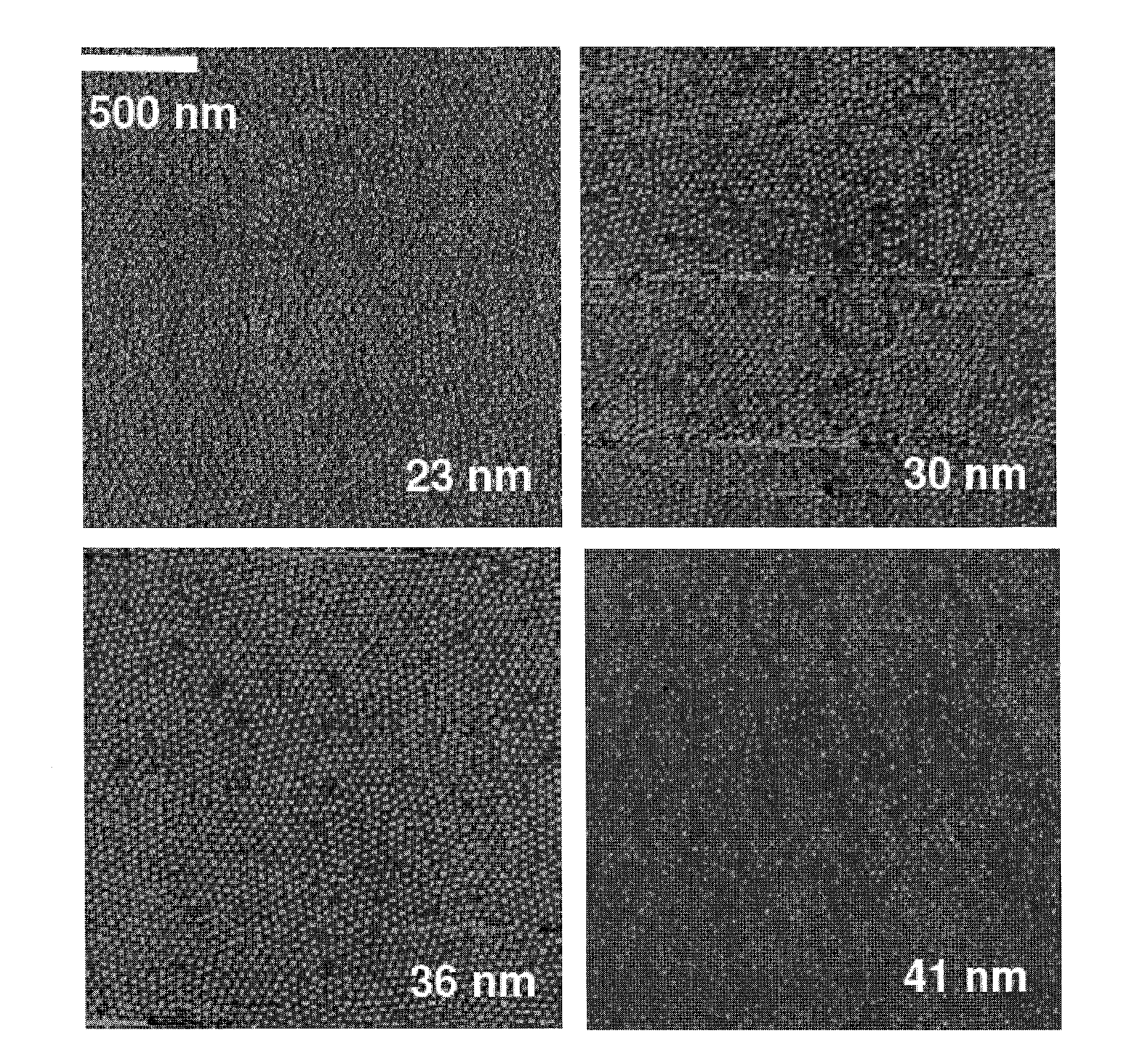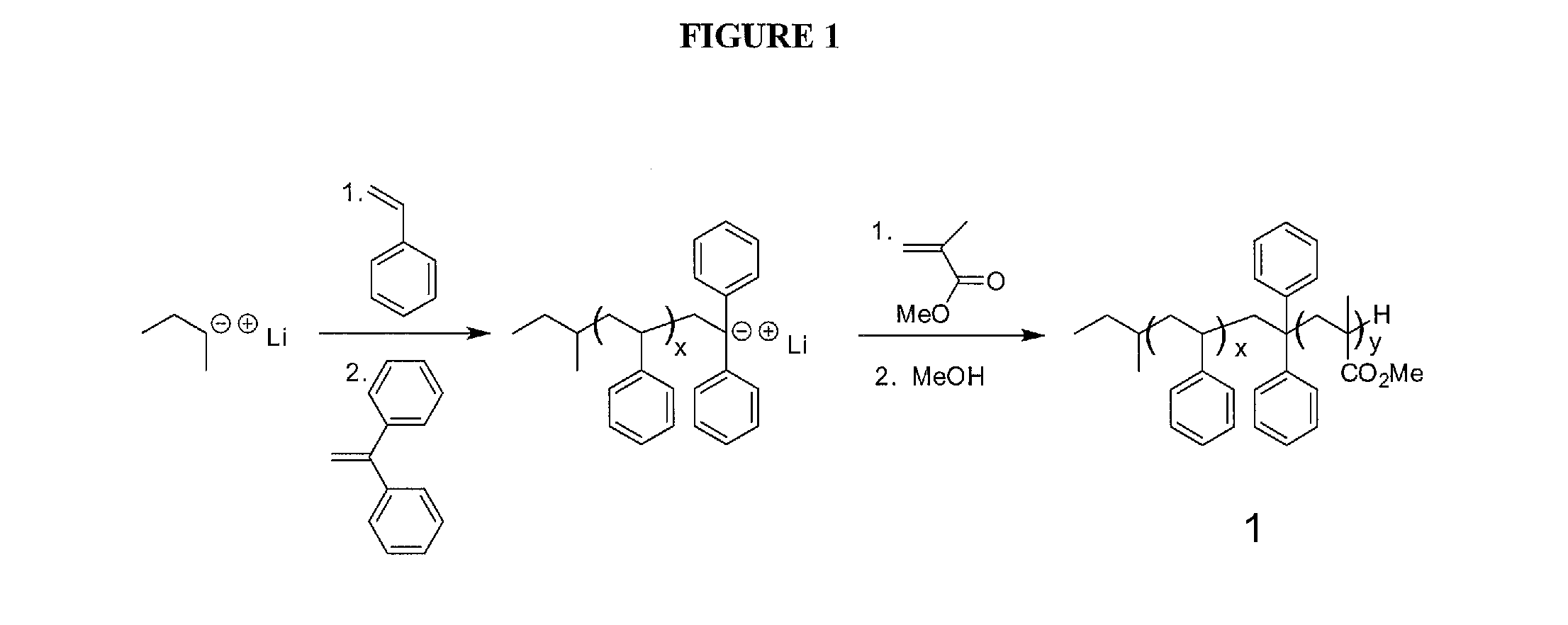Surface treatments for alignment of block copolymers
a technology of surface treatments and copolymers, applied in the field of surface treatments for block copolymers, can solve the problems of lack of control over feature size and orientation, and achieve the effect of wide process latitud
- Summary
- Abstract
- Description
- Claims
- Application Information
AI Technical Summary
Benefits of technology
Problems solved by technology
Method used
Image
Examples
example 1
Synthesis of poly(styrene-b-methyl methacrylate) (PS-b-PMMA (1))
[0030]PS-b-PMMA was synthesized as previously reported by sequential anionic polymerization of styrene and methyl methacrylate in THF at −78° C. under Ar atmosphere via standard Schlenk line techniques [11]. The initiator was sec-BuLi; diphenyl ethylene was used to properly initiate MMA, and LiCl was added to suppress side reactions during MMA propagation [12].
example 2
P(SR)-r-P(SBnAz) (3)
[0031]In a procedure adopted from Hawker et al. [9], a substituted styrene (20 mmol) and vinyl benzyl chloride (0.62 mmol) were radically copolymerized in refluxing THF (20 mL) for 48 h with enough AIBN to obtain a theoretical MW of 25 kDa. Once polymer 2 was precipitated in 0° C. MeOH, filtered, and dried in vacuo, the mol ratio of substituted styrene to vinyl benzyl chloride was determined by 1H-NMR. Taking into account this ratio and the Mn as determined by GPC, polymer 2 (1.0 g) and sodium azide (3 equiv / BnCl) were dissolved in DMF (20 mL) and stirred overnight at room temperature (rt). The polymer was precipitated in MeOH, filtered, redissolved in THF (10 mL), and stirred with H2O (1 mL) to remove any unreacted salts. Finally, the polymer was isolated by precipitation in 0° C. MeOH, filtered, and dried in vacuo to yield white powder 3. Typical yields over these two steps were 50%; IR (KBr) 2100 cm-1. Complete characterization is shown in Table 1.
example 3
Surface Treatment with PXSTs
[0032]A film of P(SR)-r-P(SBnAz) was spin coated from a 1.0 wt % solution in toluene at 3770 rpm for 30 sec onto a wafer that had been rinsed with IPA and acetone. The wafer was immediately baked at 250° C. for 5 min to cross-link the film. The wafer was then submerged in toluene for 2 min, blown dry, submerged again for 2 min, and blown dry. Typical film thicknesses as determined by ellipsometry were 15-20 nm.
PUM
| Property | Measurement | Unit |
|---|---|---|
| thickness | aaaaa | aaaaa |
| thickness | aaaaa | aaaaa |
| thickness | aaaaa | aaaaa |
Abstract
Description
Claims
Application Information
 Login to View More
Login to View More - R&D
- Intellectual Property
- Life Sciences
- Materials
- Tech Scout
- Unparalleled Data Quality
- Higher Quality Content
- 60% Fewer Hallucinations
Browse by: Latest US Patents, China's latest patents, Technical Efficacy Thesaurus, Application Domain, Technology Topic, Popular Technical Reports.
© 2025 PatSnap. All rights reserved.Legal|Privacy policy|Modern Slavery Act Transparency Statement|Sitemap|About US| Contact US: help@patsnap.com



